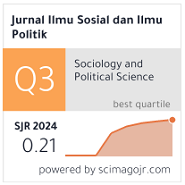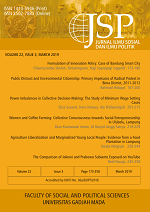| 1. | The manuscript is written in English, including research outcomes, field research or literary research and articles reflecting sociopolitical phenomena. |
| 2. | The manuscript is typed using Microsoft Word program on A4 size, around 6,500-7,000 words (excluding references) in Palatino Linotype size 11 pts and 1.5 space. |
| 3. | The writing system for research outcome consists of: |
| | Title |
| | The title should not exceed 14 words; it should be clear, concise, and informative. Abbreviations should be avoided. |
| | Name of the author |
| | The name of the author is written without any academic degree, followed by the name of author’s institution, located under the title of the article. In case manuscript written by a team, the editor is only in contact with the main author or the first mentioned. The main author must include his/her correspondence address or email. |
| | Abstract with keywords |
| | The length of abstract is around 200-250 word, while the limit of keywords is 3-5 words. The abstract, at the least, must contain the aim, methods, and result on the research. |
| | Introduction |
| | The introduction should contain (sequentially) the general background and research question or hypothesis. If there is literature review, it can be included in this chapter. The study objective should be written at the end of the introduction. |
| | Methods |
| | The research methods should elaborate on the method utilized in addressing the issues including the method of analysis. It should contain enough details allowing the reader to evaluate the appropriateness of methods as well as the reliability and validity of findings. |
| | Results |
| | The author should explain the results of research (what was discovered) in detail. |
| | Discussion |
| | The research result and discussion section contain results of the research finding and their ensuing discussions. The finding acquired from the results of the conducted research should be written with the supplementary support of adequate data. The research results and findings should be able to resolve or provide explanations to the question stated in the introduction. |
| | Conclusion |
| | The concluding statement should contain summary and suggestion. The summary should exemplify the answers provided to the hypothesis and/or research objectives or acquired findings. The summary should not contain repetition of research results and discussions, and it should instead contain a summation of research results and findings as expected in the research objective or hypothesis. The suggestions should present matters that will subsequently be conducted in relation to the research’s ensuing concepts. |
| | References |
| | All references cited in the text of the article should be written in the bibliography section. It should include references obtained from primary sources (consisting of scientific journals amounting to 80% of the entire bibliography) that have been published in the last 10 (ten) years. The remaining 20% may include research articles or research reports (thesis, books, and other relevant publications. All reference mentioned should be written down in reference using American Psychological Association (APA) style and arranged from A to Z. |
| 4. | The manuscript is to be submitted directly to the www.jurnal.ugm.ac.id/jsp by creating user account as an author. |
| 5. | Tables and figures must have titles and have clear number and sources, and be typed in single space. |
| 6. | Check each referred article for accuracy and make sure every quoted work in the article is written in References. Works that are not cited but mentioned in References will be omitted by the editor. |
| | |
| | Book with single author |
| | Reference: |
| | Anderson, B. (1983). Imagined Communities. Verso. |
| | In-text: (Anderson, 1983) |
| | |
| | Book with two author |
| | Reference: |
| | Creswell, J. W., & Poth, C. N. (2018). Qualitative Inquiry & Research Design: Choosing among Five approaches. SAGE Publications. |
| | In-text: (Creswell & Poth, 2018) |
| | |
| | Book with three author or more |
| | Reference: |
| | Dwee, D., Dion, H. B., & Brown, I. S. (2012). Information behaviour concept: A basic introduction. University of Life Press. |
| | In-text: (Dwee et al., 2012) |
| | |
| | Chapter or Article in Edited Book |
| | Reference: |
| | Hermann, M. G. (2008). Content Analysis. In A. Klotz & D. Prakash (Eds.), Research methods series. Qualitative methods in international relations (pp. 151–167). Palgrave Macmillan. |
| | In-text: (Hermann, 2008) |
| | |
| | Journal Article with DOI |
| | Reference: |
| | Kusumaningrum, D. (2016). Interdependence versus truth and justice: lessons from reconciliation processes in Maluku. Jurnal Ilmu Sosial dan Ilmu Politik, 20(1), 34-49. https://doi.org/10.22146/jsp.17998 |
| | In-text: (Kusumaningrum, 2016) |
| | |
| | Journal Article with URL |
| | Reference: |
| | Ahmann, E., Tuttle, L. J., Saviet, M., & Wright, S. D. (2018). A descriptive review of ADHD coaching research: Implications for college students. Journal of Postsecondary Education and Disability, 31(1): 24-58. https://www.ahead.org/professional-resources/publications/jped/archived-jped/jped-volume-31 |
| | In-text: (Ahmann, 2018) |
| | |
| | Newspapers article |
| | Reference: |
| | Fung, M. (2006, December 12). Asthma rates increasing. Winnipeg Free Press, pp. C4. |
| | In-text: (Fung, 2006) |
| | |
| | Newspaper article with URL |
| | Reference: |
| | Harris, M. (2011, August 16). Grades improve if classes start later, studies find. The Calgary Herald.Herald. http://www.calgaryherald.com/ |
| | In-text: (Harris, 2011) |
| | |
| | Whole Internet Site |
| | Reference: |
| | Buzan, T. (2007). Mind maps. http://www.buzanworld.com/Mind_Maps.ht |
| | In-text: (Buzan, 2007) |
| | |
| | Book translation |
| | Reference: |
| | Mancusa, S., & Viola, A. (2015). Brilliant green: The surprising history and science of plant intelligence (J. Benham, Trans.). Washington, DC: Island Press. |
| | In-text: (Mancusa & Viola, 2015) |
| | |
| | Unpublished Thesis |
| | Reference: |
| | Neo, M. C. (2000). The role of education as a process of human release from various problems of life [Unpublished M.Appl.Psy. thesis]. University of Life. |
| | In-text: (Neo, 2000) |
| | |
| | Published Thesis |
| | Reference: |
| | May, B. (2017). A survey of radial velocities in the zodiacal dust cloud. Canopus Publishing. |
| | In-text: (May, 2017) |
| | |
| | The source of the content is originally from https://lib.ugm.ac.id/?page_id=9084&lang=en with several adaptations and modifications in some areas and citation examples. |
| | |
| 9. | All manuscripts are anonymously studied by reviewers appointed by the editor according to their expertise. The author is given a chance to revise the manuscript based on the reviewer’s or the editor’s recommendation/advice. The decision |
| | of publication or rejection will be informed through the author’s email address. |
| 10. | The editor has the right to modify and correct the spelling, writing, and grammar of the published manuscript. |
| 11. | Everything related to citing permission or computer software usage in writing the manuscript or any other things related to copyright done by the author, along with all its legal consequences, becomes the author’s full responsibility. |






















